
The Asian diaspora is the diasporic group of people whose ancestral origins lie in Asia, but who live outside of the continent. There are several prominent groups within the Asian diaspora.[1]
Asian diasporas have been noted for having an increasingly transnational relationship with their ancestral homelands,[2][3] especially culturally through the use of digital media.[4][5]
East Asian diaspora
Chinese diaspora
Overseas Chinese (simplified Chinese: 海外华人 / 海外中国人; traditional Chinese: 海外華人 / 海外中國人; pinyin: Hǎiwài Huárén / Hǎiwài Zhōngguórén) refers to people of Chinese birth or ethnicity who reside outside Mainland China, Hong Kong, Macau, and Taiwan.[6] As of 2011, there were over 40.3 million overseas Chinese.[7]
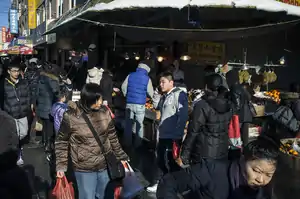
History
The Chinese people have a long history of migrating overseas, as far back as the 10th century. One of the migrations dates back to the Ming dynasty when Zheng He (1371–1435) became the envoy of Ming. He sent people – many of them Cantonese and Hokkien – to explore and trade in the South China Sea and in the Indian Ocean.
Early emigration
Different waves of immigration led to subgroups among overseas Chinese such as the new and old immigrants in Southeast Asia, North America, Oceania, the Caribbean, South America, South Africa, and Europe. In the 19th century, the age of colonialism was at its height and the great Chinese diaspora began. Many colonies lacked a large pool of laborers. Meanwhile, in the provinces of Fujian and Guangdong in China, there was a surge in emigration as a result of the poverty and village ruin.[14] The Qing ruler was forced to allow its subjects to work overseas under colonial powers. Many Hokkien chose to work in Southeast Asia (where they had earlier links starting from the Imperial Chinese era), as did the Cantonese. The area of Taishan, Guangdong Province was the source for many of the economic migrants.[15] San Francisco and California was an early American destination in the mid-1800s because of the California Gold Rush. Many settled in San Francisco forming one of the earliest Chinatowns. For the countries in North America and Australia saw great numbers of Chinese gold diggers finding gold in the gold mining and railway construction. Widespread famine in Guangdong impelled many Cantonese to work in these countries to improve the living conditions of their relatives. Some overseas Chinese were sold to South America during the Punti–Hakka Clan Wars (1855–1867) in the Pearl River Delta in Guangdong. After World War II many people from the New Territories in Hong Kong emigrated to the UK (mainly England) and to the British Raj India to help depopulation.
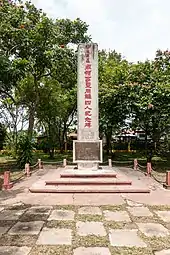
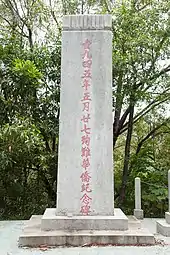
During the early and mid-19th century, the anthropometric indicators, namely height of the overseas Chinese was close to the parameters of Southern Europeans. Moreover, the average height of Southern Chinese used to be relatively stable at around 161–164 cm for males. Another important fact is that the height of Chinese emigrants varied depending on the location they have chosen. Hence, emigrants from Suriname and Indonesia were shorter than some Chinese prisoners who used to live in the U.S. and Australia.[16]
The Lanfang Republic (Chinese: 蘭芳共和國; pinyin: Lánfāng Gònghéguó) in West Kalimantan was established by overseas Chinese.
Republic of China
Under the Republicans economic growth froze and many migrated outside the Republic of China, mostly through the coastal regions via the ports of Fujian, Guangdong, Hainan and Shanghai. These migrations are considered to be among the largest in China's history. Many nationals of the Republic of China fled and settled down overseas mainly between the years 1911–1949 before the Nationalist government led by Kuomintang lost the mainland to Communist revolutionaries and relocated. Most of the nationalist and neutral refugees fled Mainland China to North America while others fled to Southeast Asia (Singapore, Brunei, Thailand, Malaysia, Indonesia and Philippines) as well as Taiwan (Republic of China).[17]
After World War II
Those who fled during 1912–1949 and settled down in Singapore and Malaysia and automatically gained citizenship in 1957 and 1963 as these countries gained independence.[18][19] Kuomintang members who settled in Malaysia and Singapore played a major role in the establishment of the Malaysian Chinese Association and their meeting hall at Sun Yat Sen Villa. There was evidence that some intended to reclaim mainland China from the CCP by funding the Kuomintang.[20][21]
During the 1950s and 1960s, the ROC tended to seek the support of overseas Chinese communities through branches of the Kuomintang based on Sun Yat-sen's use of expatriate Chinese communities to raise money for his revolution. During this period, the People's Republic of China tended to view overseas Chinese with suspicion as possible capitalist infiltrators and tended to value relationships with Southeast Asian nations as more important than gaining support of overseas Chinese, and in the Bandung declaration explicitly stated that overseas Chinese owed primary loyalty to their home nation.
From the mid-20th century onward, emigration has been directed primarily to Western countries such as the United States, Australia, Canada, Brazil, The United Kingdom, New Zealand, Argentina and the nations of Western Europe; as well as to Peru, Panama, and to a lesser extent to Mexico. Many of these emigrants who entered Western countries were themselves overseas Chinese, particularly from the 1950s to the 1980s, a period during which the PRC placed severe restrictions on the movement of its citizens. In 1984, Britain agreed to transfer the sovereignty of Hong Kong to the PRC; this triggered another wave of migration to the United Kingdom (mainly England), Australia, Canada, US, South America, Europe and other parts of the world. The 1989 Tiananmen Square protests and massacre further accelerated the migration. The wave calmed after Hong Kong's transfer of sovereignty in 1997. In addition, many citizens of Hong Kong hold citizenships or have current visas in other countries so if the need arises, they can leave Hong Kong at short notice.
In recent years, the People's Republic of China has built increasingly stronger ties with African nations. In 2014, author Howard French estimated that over one million Chinese have moved in the past 20 years to Africa.[22]
More recent Chinese presences have developed in Europe, where they number well over 1 million, and in Russia, they number over 200,000, concentrated in the Russian Far East. Russia's main Pacific port and naval base of Vladivostok, once closed to foreigners and belonged to China until the late 19th century, as of 2010 bristles with Chinese markets, restaurants and trade houses. A growing Chinese community in Germany consists of around 76,000 people as of 2010.[23] An estimated 15,000 to 30,000 Chinese live in Austria.[24]Japanese diaspora

Korean diaspora

South Asian diaspora
_without_national_boundaries.svg.png.webp)
History
Romani people
Southeast Asian diaspora
Malaysian diaspora
The Malaysian diaspora are Malaysian emigrants from Malaysia and their descendants that reside in a foreign country. Population estimates vary from seven hundred thousand to one million, both descendants of early emigrants from Malaysia, as well as more recent emigrants from Malaysia. The largest of these foreign communities are in Singapore, Australia, Brunei and the United Kingdom.
Emigration from Malaysia is a complex demographic phenomenon existing for decades and having a number of reasons, with institutional racism being one of the major factors. The process is the reverse of the immigration to Malaysia. Malaysia does not keep track of emigration, and counts of Malaysians abroad are thus only available courtesy of statistics kept by the destination countries. As of 2019, according to the United Nations Department of Economic and Social Affairs, the population of the Malaysian diaspora stands at 1,730,152.[38]Filipino diaspora
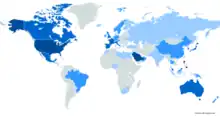
Thai diaspora
Overseas Thai people (Thai: คนไทยพลัดถิ่น, คนไทยในต่างแดน) number approximately 1.1 million persons worldwide. They can be roughly divided into two groups:
A "non-resident Thai" is a citizen of Thailand who holds a Thai passport and has temporarily emigrated to another country for employment, residence, education or any other purpose. The Bank of Thailand estimates that, as of 2016, 1,120,837 Thais worked overseas.[40]Vietnamese diaspora
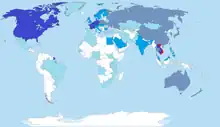
Overseas Vietnamese (Vietnamese: người Việt hải ngoại, Việt kiều or kiều bào) refers to Vietnamese people who live outside Vietnam. There are approximately 5 million overseas Vietnamese, the largest community of whom live in the United States.
Overseas Vietnamese make up the fifth largest Asian diaspora, after the Indian diaspora, Overseas Chinese, Overseas Filipinos and the Lebanese diaspora.West Asian diaspora
Arab diaspora

Arab diaspora is a term that refers to descendants of the Arab emigrants who, voluntarily or as forcibly, migrated from their native lands to non-Arab countries, primarily in the Americas, Europe, Southeast Asia, and West Africa.
Immigrants from Arab countries, such as Sudan, Syria and Palestine, also form significant diasporas in other Arab states.Iranian diaspora

The Iranian diaspora refers to Iranian citizens or people of Iranian descent living outside Iran.[41]
This includes the varying ethnicities of the Iranian people including the following groups: Persians, Azeris, Kurds, Lors, Baluchs, Arabs, Turkomens, Assyrians, and Armenians.
In 2021, the Ministry of Foreign Affairs of Iran published statistics, which showed that 4,037,258 Iranians are living abroad, an increase from previous years.[42][43] Many of them live in North America, Europe, the Arab states of the Persian Gulf, Turkey, Azerbaijan, Australia and the broader Middle East.[44][45] Other studies have estimated about 1.5 million or fewer Iranians living abroad.[46] Many of them migrated to other countries after the Iranian Revolution in 1979.[47][48]Jewish diaspora

The Jewish diaspora (Hebrew: תְּפוּצָה, romanized: təfūṣā) or exile (Hebrew: גָּלוּת gālūṯ; Yiddish: golus)[lower-alpha 1] is the biblical dispersion of Israelites or Jews out of their ancient ancestral homeland (the Land of Israel) and their subsequent settlement in other parts of the globe.[51][52]
In terms of the Hebrew Bible, the term "Exile" denotes the fate of the Israelites who were taken into exile from the Kingdom of Israel during the 8th century BCE, and the Judahites from the Kingdom of Judah who were taken into exile during the 6th century BCE. While in exile, the Judahites became known as "Jews" (יְהוּדִים, or Yehudim), "Mordecai the Jew" from the Book of Esther being the first biblical mention of the term.
The first exile was the Assyrian exile, the expulsion from the Kingdom of Israel (Samaria) begun by Tiglath-Pileser III of Assyria in 733 BCE. This process was completed by Sargon II with the destruction of the kingdom in 722 BCE, concluding a three-year siege of Samaria begun by Shalmaneser V. The next experience of exile was the Babylonian captivity, in which portions of the population of the Kingdom of Judah were deported in 597 BCE and again in 586 BCE by the Neo-Babylonian Empire under the rule of Nebuchadnezzar II.Turkish diaspora

The Turkish diaspora (Turkish: Türk diasporası or Türk gurbetçiler) refers to ethnic Turkish people who have migrated from, or are the descendants of migrants from, the Republic of Turkey, Northern Cyprus or other modern nation-states that were once part of the former Ottoman Empire. Therefore, the Turkish diaspora is not only formed by people with roots from mainland Anatolia and Eastern Thrace (i.e. the modern Turkish borders); rather, it is also formed of Turkish communities which have also left traditional areas of Turkish settlements in the Balkans (such as Bulgaria, Greece, North Macedonia, Romania, etc.), the island of Cyprus, the region of Meskhetia in Georgia, and the Arab world (such as Algeria, Iraq, Lebanon).
In particular, most mainland Turkish migration has been to Western and Northern Europe. Meanwhile, almost all the Turkish minorities in former Ottoman lands have a large diaspora in Turkey, many having migrated as muhacirs (refugees); furthermore, the Cretan Turks have migrated throughout the Levant; Cypriot Turks have a significant diaspora in the English-speaking countries (especially the UK and Australia); the Meskhetian Turks have a large diaspora in Central Asia; and Algerian Turks and Tunisian Turks have mostly settled in France. Since Bulgarian Turks and Romanian Turks gained EU citizenship in 2007, their diasporas in Western Europe significantly increased once restrictions on movement came to a halt in 2012.Central Asian diaspora
See also
Notes
- ↑ Other Ashkenazic- or Yiddish-based variants include galus, goles and golus.[49] A Hebrew-based variant spelling is galuth.[50]
References
- ↑ Parreñas, Rhacel S.; Siu, Lok C.D., eds. (2007-11-30), "Asian Diasporas: New Formations, New Conceptions", Asian Diasporas, Stanford University Press, doi:10.1515/9780804767828, ISBN 978-0-8047-6782-8, S2CID 246220255, retrieved 2023-11-09
- ↑ Goh, Robbie B. H.; Wong, Shawn (2004-03-01). Asian Diasporas: Cultures, Indentity, Representation. Hong Kong University Press. ISBN 978-962-209-672-1.
- ↑ "Introduction: Theorizing the Asian Diaspora". Retrieved 2023-11-09.
- ↑ Cunningham, Stuart; Sinclair, John (2001). Floating Lives: The Media and Asian Diasporas. Rowman & Littlefield. ISBN 978-0-7425-1136-1.
- ↑ Um, Hae-kyung (2004-11-04). Diasporas and Interculturalism in Asian Performing Arts: Translating Traditions. Routledge. ISBN 978-1-135-78990-9.
- ↑ Goodkind, Daniel. "The Chinese Diaspora: Historical Legacies and Contemporary Trends" (PDF). U.S. Census Bureau. Archived (PDF) from the original on 2020-02-20. Retrieved 31 August 2021.
- ↑ Poston, Dudley; Wong, Juyin (2016). "The Chinese diaspora: The current distribution of the overseas Chinese population". Chinese Journal of Sociology. 2 (3): 356–360. doi:10.1177/2057150X16655077. S2CID 157718431.
- ↑ "Yearbook of Immigration Statistics: 2012 Supplemental Table 2". U.S. Department of Homeland Security. Archived from the original on 3 April 2013. Retrieved 2 May 2013.
- ↑ "Yearbook of Immigration Statistics: 2011 Supplemental Table 2". U.S. Department of Homeland Security. Archived from the original on 8 August 2012. Retrieved 27 April 2013.
- ↑ "Yearbook of Immigration Statistics: 2010 Supplemental Table 2". U.S. Department of Homeland Security. Archived from the original on 12 July 2012. Retrieved 27 April 2013.
- ↑ John Marzulli (9 May 2011). "Malaysian man smuggled illegal Chinese immigrants into Brooklyn using Queen Mary 2: authorities". New York: NY Daily News.com. Archived from the original on 5 May 2015. Retrieved 27 April 2013.
- ↑ "Chinese New Year 2012 in Flushing". QueensBuzz.com. 25 January 2012. Archived from the original on 30 March 2013. Retrieved 2 May 2013.
- ↑ "SELECTED POPULATION PROFILE IN THE UNITED STATES 2017 American Community Survey 1-Year Estimates New York-Newark, NY-NJ-CT-PA CSA Chinese alone". United States Census Bureau. Archived from the original on 14 February 2020. Retrieved 27 January 2019.
- ↑ The Story of California From the Earliest Days to the Present, by Henry K. Norton. 7th ed. Chicago, A.C. McClurg & Co., 1924. Chapter XXIV, pp. 283–96.
- ↑ Pan, Lynn, ed. (April 1999). "Huaqiao". The Encyclopedia of the Chinese Overseas. Harvard University Press. ISBN 0674252101. LCCN 98035466. Archived from the original on 17 March 2009. Retrieved 17 March 2009.
- ↑ Baten, Jörg (November 2008). "Anthropometric Trends in Southern China, 1830-1864". Australian Economic History Review. 43 (3): 209–226. doi:10.1111/j.1467-8446.2008.00238.x.
- ↑ "Chiang Kai Shiek". Sarawakiana. Archived from the original on 6 December 2012. Retrieved 28 August 2012.
- ↑ Yong, Ching Fatt. "The Kuomintang Movement in British Malaya, 1912–1949". University of Hawaii Press. Archived from the original on 10 November 2013. Retrieved 29 September 2013.
- ↑ Tan, Kah Kee (2013). The Making of an Overseas Chinese Legend. World Scientific Publishing Company. doi:10.1142/8692. ISBN 978-981-4447-89-8.
- ↑ Jan Voon, Cham (2002). "Kuomintang's influence on Sarawak Chinese". Sarawak Chinese political thinking : 1911–1963 (master thesis). University of Malaysia Sarawak (UNIMAS). Retrieved 28 August 2012.
- ↑ Wong, Coleen (10 July 2013). "The KMT Soldiers Who Stayed Behind In China". The Diplomat. Archived from the original on 10 November 2013. Retrieved 29 September 2013.
- ↑ French, Howard (November 2014). "China's Second Continent: How a Million Migrants Are Building a New Empire in Africa". Foreign Affairs. Archived from the original on 6 November 2021. Retrieved 9 August 2020.
- ↑ "Deutsch-Chinesisches Kulturnetz". De-cn.net (in German). Archived from the original on 13 April 2012. Retrieved 6 February 2017.
- ↑ "Heimat süßsauer" (PDF). Eu-china.net (in German). Archived (PDF) from the original on 2011-07-21. Retrieved 27 May 2018.
- ↑ "Ancient Japanese pottery in Boljoon town". 30 May 2011.
- ↑ Manansala, Paul Kekai (5 September 2006). "Quests of the Dragon and Bird Clan: Luzon Jars (Glossary)".
- ↑ Cole, Fay-Cooper (1912). "Chinese Pottery in the Philippines" (PDF). Field Museum of Natural History. Anthropological Series. 12 (1).
- ↑ "Philippines History, Culture, Civilization and Technology, Filipino". asiapacificuniverse.com.
- ↑ さや・白石; Shiraishi, Takashi (1993). The Japanese in Colonial Southeast Asia. SEAP Publications. ISBN 9780877274025.
- ↑ Ministry of Foreign Affairs (MOFA), Japan: Japan-Mexico relations
- ↑ Palm, Hugo. "Desafíos que nos acercan," Archived 15 April 2009 at the Wayback Machine El Comercio (Lima, Peru). 12 March 2008.
- ↑ Azuma, Eiichiro (2005). "Brief Historical Overview of Japanese Emigration". International Nikkei Research Project. Archived from the original on 19 February 2007. Retrieved 2007-02-02.
- ↑ 재외동포현황(2021)/Total number of overseas Koreans (2021). South Korea: Ministry of Foreign Affairs. 2021. Archived from the original on February 24, 2021. Retrieved 2022-08-21.
- ↑ Schwekendiek, Daniel (2012). Korean Migration to the Wealthy West. New York: Nova Publishers.
- ↑ "The Desi Diaspora: Politics, Protest, and Nationalism". academic.oup.com. Retrieved 2023-11-08.
- ↑ Rai, Rajesh; Reeves, Peter (2008-07-25). The South Asian Diaspora: Transnational Networks and Changing Identities. Routledge. ISBN 978-1-134-10595-3.
- ↑ "Cracking the entertainment code for the South Asian diaspora: ZEE5 Global's strategies for the US pay off". The Times of India. 2023-11-07. ISSN 0971-8257. Retrieved 2023-11-08.
- ↑ "International migrant stock 2019". United Nations. Retrieved June 25, 2020.
Figures includes Malaysians in UN member nations
- ↑ "Remittances from Filipinos abroad reach 2.9 bln USD in August 2019 - Xinhua | English.news.cn". www.xinhuanet.com. Archived from the original on October 15, 2019.
- ↑ Rujivanarom, Pratch (2017-12-23). "Thais working abroad prone to exploitation". The Nation. Retrieved 8 May 2018.
- ↑ "Diaspora". Iranicaonline.org. Encyclopædia Iranica. December 15, 1995. pp. 370–387. Archived from the original on 9 February 2015. Retrieved 8 February 2015.
- ↑ "Archived copy" (PDF). Archived from the original (PDF) on 2021-06-05. Retrieved 2021-06-06.
{{cite web}}: CS1 maint: archived copy as title (link) - ↑ "آمار پراکندگی ایرانیان مقیم خارج از کشور + نمودار". Gostaresh.news. Retrieved 2022-08-05.
- ↑ Esfandiari, Golnaz (2004-03-08). "Iran: Coping With The World's Highest Rate Of Brain Drain - RADIO FREE EUROPE / RADIO LIBERTY". Rferl.org. Archived from the original on 2008-04-29. Retrieved 2012-12-10.
- ↑ "Migration Information Source - Iran: A Vast Diaspora Abroad and Millions of Refugees at Home". Migrationinformation.org. Archived from the original on 2014-02-15. Retrieved 2012-12-10.
- ↑ According to one 2012-Pew study there were only 1,340,000 Iranian-born expatriates."Faith on the Move: The Religious Affiliation of International Migrants". Pewforum.org. 2012-03-08. Archived from the original on 2013-01-22. Retrieved 2012-12-10.
- ↑ Saeed Zeydabadi-Nejad, The Politics of Iranian Cinema: Film and Society in the Islamic Republic, Routledge (2009), p. 17
- ↑ Bagherpour, Amir (September 12, 2020). "The Iranian Diaspora in America: 30 Years in the Making". Frontline. Tehran Bureau, PBS.
- ↑ "golus". Jewish English Lexicon.
- ↑ "galuth". Merriam-Webster.com Dictionary.: “Etymology: Hebrew gālūth”
- ↑ "Diaspora | Judaism". Encyclopedia Britannica. Retrieved 2018-07-12.
- ↑ Ben-Sasson, Haim Hillel. "Galut." Encyclopaedia Judaica, edited by Michael Berenbaum and Fred Skolnik, 2nd ed., vol. 7, Macmillan Reference (US) 2007, pp. 352–63. Gale Virtual Reference Library
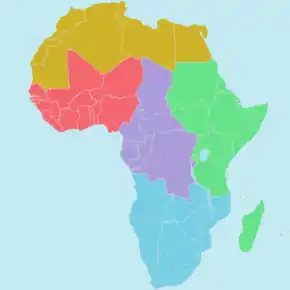
.svg.png.webp)